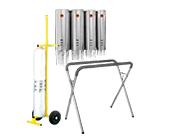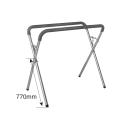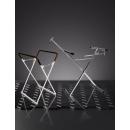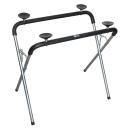Professional bodywork trestle

Professional bodywork trestle
-
 TRSTDStandard trestle102cm x 103cm
TRSTDStandard trestle102cm x 103cm -
 9150.0002Treteau premium128 x 61cm
9150.0002Treteau premium128 x 61cm -
 140.2225Suction cup standwindscreen
140.2225Suction cup standwindscreen
︾
Everything you need to know about bodywork trestles:
Bodywork trestles play a crucial role in the automotive bodywork industry by providing stable, adjustable support for vehicle parts during repair and paint work. Their importance is multi-faceted and has a direct impact on the quality of work and the safety of operations. Here are a few key points to understand the importance of bodywork trestles:
Stable support :
Bodywork trestles provide a solid base to support the various parts of a vehicle during repair work. This allows technicians easy access to all areas of the bodywork, promoting accurate execution of tasks.
Adjustability:
Most bodywork trestles are adjustable in height, tilt and sometimes orientation. This adjustability is crucial for adapting to different vehicle sizes and shapes, ensuring maximum compatibility with repair operations.
Easy access:
By raising the car to an ergonomic height, bodywork trestles give technicians comfortable access to all parts of the vehicle. This improves visibility and simplifies the repair process, particularly for areas close to the ground.
Safety:
By properly supporting vehicle parts, bodywork trestles help to ensure safe operations. They reduce the risk of injury from unexpected movements or structural collapse during work.
Accurate repairs:
The use of bodywork trestles enables technicians to work with greater precision. This is particularly crucial when applying paint or carrying out meticulous repairs, as a stable base contributes to more professional results.
Workspace management:
Bodywork trestles offer an organised way of managing workspace in a body shop. By raising vehicles, they free up floor space, making it easier to move tools and clean the workshop.
Versatility:
Bodywork trestles are versatile and can be used for a variety of tasks, from surface preparation to Paint and repair. Their robust design means they can withstand a wide range of loads.
In short, bodywork trestles are not just practical supports, but essential tools for bodywork professionals. Their use contributes to operational efficiency, repair quality and overall safety in the bodyshop.
Focus on the differences between bodywork trestles for workshops:
1. Suction cup support trestle
Features:
Fitted with suction cups for optimum adhesion to vehicle bodywork.
Designed to hold light to medium-heavy parts during repair and paint work.
Often adjustable in height and inclination to suit different body shapes.
Use:
Ideal for holding lightweight panels or flat components in place during paint or repair work.
2. Foam support stand :
Features:
Foam coating on parts in contact with the bodywork to prevent scratches and damage.
Robust construction to support medium to heavy parts.
Adjustable height and sometimes tilt for versatility of use.
Use:
Suitable for repair work where protection of the bodywork surface is crucial.
3. Premium bodywork trestle:
Features:
Robust, durable construction to support heavy loads.
Height-adjustable to suit different working heights.
May have additional features such as locking mechanisms or non-slip feet.
Use:
Suitable for bodywork involving heavier loads and requiring maximum stability.
4. Standard bodywork trestle:
Features:
Solid construction but often less robust than premium models.
Adjustable height to suit a variety of needs.
Generally more economical than premium models.
Application:
Suitable for routine bodywork where lighter loads need to be supported.
General comparison: The differences between these supports lie mainly in their design, load capacity and specific features. Suction cup and foam trestles focus on protecting the bodywork, while premium trestles aim to provide maximum stability for heavier loads. Standard trestles, although less robust, offer an economical solution for lighter bodywork work. The choice will depend on the specific needs of each job in a body shop.
The most common questions about using a bodywork trestle :
The use of a bodywork trestle is common practice in the automotive bodywork industry to support parts during repair and paint work. Here are some answers to questions frequently asked by users about the use of this essential equipment:
1. Why should I use a bodywork trestle in my bodyshop?
Bodywork trestles provide a stable, adjustable support to hold vehicle parts in place during work. They improve precision, safety and ease of access to repair areas.
2. How do I choose the right bodywork trestle for my needs?
Consider load capacity, stability, height and tilt adjustability, and other features specific to your needs. Choose a model suited to the size and weight of the parts you frequently handle.
3. What is the maximum load capacity of a typical bodywork trestle?
Load capacity can vary, but many bodywork trestles have a capacity ranging from a few hundred to over a thousand kilograms, depending on the model. Choose a trestle according to the loads you plan to handle.
4. How can I adjust the height of a bodywork trestle?
Most bodywork trestles have height adjustment mechanisms, such as jacks or clamps. Follow the manufacturer's instructions to adjust the height safely and stably.
5. Are all bodywork trestles suitable for all types of bodywork?
No, different bodywork trestles are designed to meet specific needs. Some are better suited to light work, while others are designed to support heavier loads. Choose according to your specific needs.
6. Can bodywork trestles damage the vehicle's bodywork?
To minimise the risk, opt for bodywork trestles with foam or rubber pads on the parts that come into contact with the bodywork. Also make sure that the surface of the trestle is clean to avoid any contamination that could cause scratches.
7. Can I use a bodywork stand to support plastic parts?
Yes, some bodywork trestle models are designed to support plastic parts. Make sure you choose a trestle that is suitable for plastic surfaces and has appropriate holding mechanisms.
8. How can I properly store and maintain my bodywork trestles?
Store them in a dry place to prevent corrosion. Check the adjustment mechanisms regularly to ensure they are working properly. Clean the surfaces in contact with the body to prevent the transfer of contaminants.
In conclusion, the use of a bodywork trestle is an essential practice in a bodywork workshop, improving productivity, safety and the quality of repair work. Select a trestle adapted to your specific needs and follow the manufacturer's instructions for optimum use.